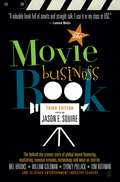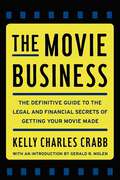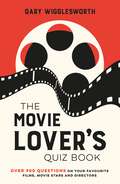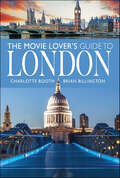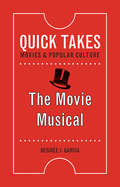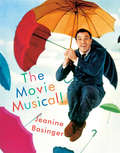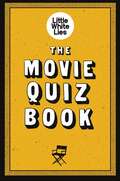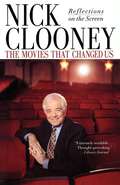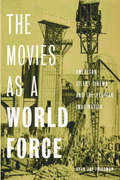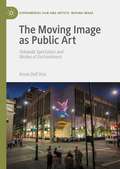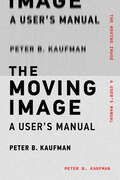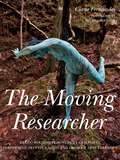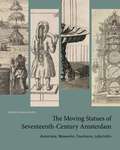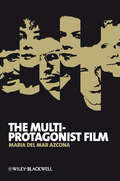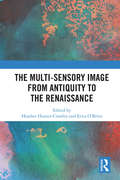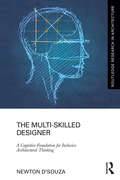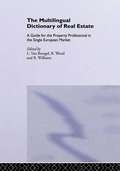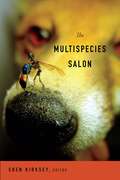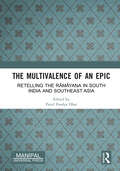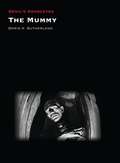- Table View
- List View
The Movie Business Book, Third Edition
by Jason E. SquireDrawing from a variety of experts in an industry that has seen major technological advances since the second edition, The Movie Business Book, Third Edition, offers the most comprehensive, authoritative overview of this fascinating, global business. A must-read for industry newcomers, film students and movie buffs, this new edition features key movers and shakers, such as Tom Rothman, chairman of Fox Filmed Entertainment; Michael Grillo, head of Feature Film Production at DreamWorks SKG; Sydney Pollack; Mel Brooks; and many others. A definitive sourcebook, it covers nuts-and-bolts details about financing, revenue streams, marketing, DVDs, globalization, the Internet and new technologies. All of this -- and more -- is detailed in this new edition of the classic Movie Business Book.
The Movie Business: The Definitive Guide to the Legal and Financial Secrets of Getting Your Movie Made
by Kelly CrabbMaking a movie may be part art and part science, but it's 100 percent business. In this comprehensive and accessible guide, Kelly Charles Crabb shares the information necessary to understand the legal and financial challenges involved in getting a film from story to the silver screen and beyond. Drawing on over twenty years of experience in the entertainment industry, as both lawyer and producer, Crabb reveals his insider's knowledge on: Understanding copyright and intellectual property law Obtaining financial backing Selecting and hiring the key players Overseeing the filming Locking in the theatrical, home video, and TV distribution Understanding merchandise licensing and everything else you need to know to make a serious run at producing and exploiting a movie. Offering hands-on illustrations from actual movie contracts to show how the basic deals for each of the many stages are assembled, the author explains in plain and simple terms what the contracts contain and why. It gives the big picture and the finer points of movie making -- from concept to raking in the last dollar after the film is completed. While it may not transform you into a lawyer or an industry accountant -- and that's not what you want anyway -- it will take you through all the business and legal principles you need to know to be a successful and knowledgeable professional producer.
The Movie Lover's Quiz Book: A Compendium of Over 900 Questions on Your Favourite Films, Movie Stars and Directors
by Gary WigglesworthDo you consider yourself a fan of the movie world and want to put your knowledge to the test? Or perhaps you know someone who lives and breathes cinema who would love this book?Whether you want to challenge yourself or someone else, The Movie Lover's Quiz Book is perfect for any cinephile. Inside you'll find a fun range of rounds and an eclectic mix of questions, all designed to give you hours of entertainment.From Rhyming Films and Say What You See, to One Star Reviews and Name the Year, there are twenty quizzes of picture clues, connections, conundrums, multiple choices and much, much more. Interspersed with fascinating film facts, this book is guaranteed to make you even more of a movie buff than you already are.It's time to immerse yourself in the colour and magic of the big screen and get ready for the...Lights, Camera... Questions!
The Movie Lover’s Guide to London (City Guides)
by Charlotte Booth Brian BillingtonLondon is a magical place which has intrigued people for more than 2,000 years, and never is this more apparent than in the past 130 years following the invention of the moving image. London has been a draw for filmmakers for decades, and this book guides you through the locations, in the shadow of some of your favorite movies. Take a tour by movie, go on a movie pub crawl, a leisurely stroll through cemeteries with connections to the movies or create your own tour by postcode. This book will allow you to visit new parts of London but with the familiarity of a well-loved film. With more than 500 movie locations from 91 films covering more than six decades of movie making and more than 100 images, this book will have something for everyone and will show you London in a new, sparkling, glamourous light.
The Movie Musical (Quick Takes: Movies and Popular Culture)
by Desirée J. GarciaPutting Asian and European musicals into conversation with Hollywood classics like Singin’ in the Rain and La La Land, this study demonstrates the flexibility and durability of the genre. It explores how the movie musical mediates between nostalgia and technical innovation, while foregrounding the experiences of women, immigrants, and people of color.
The Movie Musical!
by Jeanine BasingerIrresistible and authoritative, The Movie Musical! is an in-depth look at the singing, dancing, happy-making world of Hollywood musicals, beautifully illustrated in color and black-and-white--an essential text for anyone who's ever laughed, cried, or sung along at the movies.Leading film historian Jeanine Basinger reveals, with her trademark wit and zest, the whole story of the Hollywood musical--in the most telling, most incisive, most detailed, most gorgeously illustrated book of her long and remarkable career. From Fred Astaire, whom she adores, to La La Land, which she deplores, Basinger examines a dazzling array of stars, strategies, talents, and innovations in the history of musical cinema. Whether analyzing a classic Gene Kelly routine, relishing a Nelson-Jeanette operetta, or touting a dynamic hip hop number (in the underrated Idlewild), she is a canny and charismatic guide to the many ways that song and dance have been seen--and heard--on film. With extensive portraits of everyone from Al Jolson, the Jazz Singer; to Doris Day, whose iconic sunniness has overshadowed her dramatic talents; from Deanna Durbin, that lovable teen-star of the '30s and '40s; to Shirley T. and Judy G.; from Bing to Frank to Elvis; from Ann Miller to Ann-Margret; from Disney to Chicago . . . focusing on many beloved, iconic films (Top Hat; Singin' in the Rain; Meet Me in St. Louis; The Sound of Music) as well as unduly obscure gems (Eddie Cantor's Whoopee!; Murder at the Vanities; Sun Valley Serenade; One from the Heart), this book is astute, informative, and pure pleasure to read.
The Movie Quiz Book
by Little White LiesImagine the best pub quiz you've ever been to, but without suffering the hangover the next morning!From heroic heroines, famous final lines and award-winning directors, to Hollywood's golden age, memorable movie flops and the film world's biggest franchises, the book's over 1,600 questions cover every aspect of the movies. Thrown in among the brain-testing questions are a series of visual quizzes and challenges—including an It's a Wonderful Life spot-the-difference and the world premiere of a Jean-Claude van Damme-themed wordsearch!Put together by the team at indie film magazine Little White Lies, The Movie Quiz Book includes 120 movie quizzes, from seriously difficult text-based, to downright silly illustrated visual quizzes.The Movie Quiz Book is illustrated by Sophie Mo.
The Movie Quiz Book
by White LiesImagine the best pub quiz you've ever been to, but without suffering the hangover the next morning!From heroic heroines, famous final lines and award-winning directors, to Hollywood's golden age, memorable movie flops and the film world's biggest franchises, the book's over 1,600 questions cover every aspect of the movies. Thrown in among the brain-testing questions are a series of visual quizzes and challenges—including an It's a Wonderful Life spot-the-difference and the world premiere of a Jean-Claude van Damme-themed wordsearch!Put together by the team at indie film magazine Little White Lies, The Movie Quiz Book includes 120 movie quizzes, from seriously difficult text-based, to downright silly illustrated visual quizzes.The Movie Quiz Book is illustrated by Sophie Mo.
The Moviemaking with Your Camera Field Guide: The Essential Guide To Shooting Video With Hdslrs And Digital Cameras (Field Guide Ser.)
by Olivia SperanzaUnknowingly, photographers are already trained in many of the key skills behind great cinematography not least the arts of lighting and composition. Now, with the advent of high-definition video recording capabilities, the cameras have finally caught up. The Moviemaking With Your Camera Field Guide is a pocket-size guide that shows photographers how they can build on what they already know to create truly spectacular movies with their HDSLR camera. It introduces everything from the language of film and basic equipment, to the art of post-production and publishing new work. Includes creating filmmaking project ideas. "
The Moviemaking with Your Camera Field Guide: The Essential Guide to Shooting Video with HDSLRs and Digital Cameras (Field Guide Ser.)
by Olivia SperanzaAny photographer with a modern digital camera can be a moviemaker, and this book shows you all the skills you'll need to shoot everything, from a video-blog to a feature film. Build on your photographic skills - this knowledge predisposes you to create great cinematography - and understand the technical and practical necessities of high-definition video.The Moviemaking With Your Camera Field Guide shows you how you can build on what you already know to create truly spectacular movies with your DSLR in whatever genre you choose. It introduces everything from the language of film and basic equipment you will need, to the art of post-production and publishing your new work.Exclusive video content to accompany this book is available online.
The Movies That Changed Us: Reflections On The Screen
by Nick ClooneyTwenty movies that had an impact on society.
The Movies That Changed Us: Reflections on the Screen
by Nick ClooneyThere are movies we love, but only one movie in a thousand actually changes the way we live, the way we look at life, or the way we define entertainment. Broadcast journalist Nick Clooney, best known as the silver-haired movie host on the cable channel American Movie Classics, has selected twenty movies that changed us, some for the better, some for the worse. He starts with the recent past: Saving Private Ryan, a movie that changed the way people across the world view the American generation that fought World War Two; Star Wars, a motion picture so important that a missile defense system was named for it; and The Birth of a Nation, not only the first film to be hailed as the artistic equivalent to opera, literature, and painting, but also the first film to give a cloak of respectability to racial prejudice. Clooney's debate-starting distinctions will engage, delight, and challenge everyone who loves movies: Did Taxi Driver change the way we view individual violence? Did The Graduate change the way we view romance? Did Dr. Strangelove change the way we contemplate mass destruction? Did The Best Years of Our Lives alter our behavior toward veterans? And did Triumph of the Will almost help the Nazis win the war? Clooney ends with an epilogue on "The Movie That Never Was": the film that could have spurred the civil rights movement if only it had been made. "Sports changed things, the military changed things, and eventually the federal government changed things," Clooney writes, but in the matter of race, he concludes, the movies changed nothing. Thought-provoking, entertaining, and compulsively readable, The Movies That Changed Us will delight film fans of every generation.
The Movies as a World Force: American Silent Cinema and the Utopian Imagination
by Ryan Jay FriedmanThroughout the silent-feature era, American artists and intellectuals routinely described cinema as a force of global communion, a universal language promoting mutual understanding and harmonious coexistence amongst disparate groups of people. In the early 1920s, film-industry leaders began to espouse this utopian view, in order to claim for motion pictures an essentially uplifting social function. The Movies as a World Force examines the body of writing in which this understanding of cinema emerged and explores how it shaped particular silent films and their marketing campaigns. The utopian and universalist view of cinema, the book shows, represents a synthesis of New Age spirituality and the new liberalism. It provided a framework for the first official, written histories of American cinema and persisted as an advertising trope, even after the transition to sound made movies reliant on specific national languages.
The Moving Image as Public Art: Sidewalk Spectators and Modes of Enchantment (Experimental Film and Artists’ Moving Image)
by Annie Dell'AriaThis book maps the presence of moving images within the field of public art through encounters with passersby. It argues that far from mere distraction or spectacle, moving images can produce moments of enchantment that can renew, intensify, or challenge our everyday engagement with public space and each other. These artworks also offer frameworks for understanding how moving images operate in public space—how they move viewers and reconfigure the site of the screen. Each chapter explores a mode of address that examines how artists and curators leverage the moving image’s attentional power to engage audiences, create spaces, make place, and challenge assumptions. This book also examines the difficulties and compromises that arise when using urban screens for public art.
The Moving Image: A User's Manual
by Peter B. KaufmanThe definitive guidebook for using video in modern communication.Video (television, film, the moving image generally) is today&’s most popular information medium. Two-thirds of the world&’s internet traffic is video. Americans get their news and information more often from screens and speakers than through any other means. The Moving Image is the first authoritative account of how we have arrived here, together with the first definitive manual to help writers, educators, and publishers use video more effectively. Drawing on decades as an educator, publisher, and producer, MIT&’s Peter Kaufman presents new tools, best practices, and community resources for integrating film and sound into media that matters.Kaufman describes video&’s vital role in politics, law, education, and entertainment today, only 130 years since the birth of film. He explains how best to produce video, distribute it, clear rights to it, cite it, and, ultimately, archive and preserve it. With detailed guidance on producing and deploying video and sound for publication, finding and using archival video and sound, securing rights and permissions, developing distribution strategies, and addressing questions about citation, preservation, and storage—across the broadest spectrum of platforms, publications, disciplines, and formats—The Moving Image equips readers for the medium&’s continued ascendance in education, publishing, and knowledge dissemination in the decades to come. And, modeled in part on Strunk and White&’s classic, The Elements of Style, it&’s also a highly enjoyable read.
The Moving Researcher: Laban/Bartenieff Movement Analysis in Performing Arts Education and Creative Arts Therapies
by Jackie Hand Ciane Fernandes Rosel Grassmann Julio Mota Melina Scialom Susanne Schlicher Regina MirandaThis comprehensive book will serve as a step-by-step guide to Laban/Bartenieff Movement Analysis, updating and expanding concepts and practices. Following extensive research on the method developed by Rudolf von Laban and his disciples, this book explains movement principles, exercises, and motif symbols in detail. Organized according to the four categories of Laban/Bartenieff Movement Analysis (Body-Effort-Shape-Space), additional chapters present the different developments of the theory in relation to performing arts and movement therapy. The author draws on Laban/Bartenieff Movement Analysis as a dynamic and connective approach, traveling from classroom and studio to everyday life, stage performance, and film acting. The Laban perspective serves as a multimedia artistic viewpoint, intertwining theory, learning, and imagery. This unique approach to this internationally used method is essential reading for educators and students of dance and other performing arts and movement-related professions.
The Moving Statues of Seventeenth-Century Amsterdam: Automata, Waxworks, Fountains, Labyrinths
by Angela VanhaelenThis book opens a window onto a fascinating and understudied aspect of the visual, material, intellectual, and cultural history of seventeenth-century Amsterdam: the role played by its inns and taverns, specifically the doolhoven.Doolhoven were a type of labyrinth unique to early modern Amsterdam. Offering guest lodgings, these licensed public houses also housed remarkable displays of artwork in their gardens and galleries. The main attractions were inventive displays of moving mechanical figures (automata) and a famed set of waxwork portraits of the rulers of Protestant Europe. Publicized as the most innovative artworks on display in Amsterdam, the doolhoven exhibits presented the mercantile city as a global center of artistic and technological advancement. This evocative tour through the doolhoven pub gardens—where drinking, entertainment, and the acquisition of knowledge mingled in encounters with lively displays of animated artifacts—shows that the exhibits had a forceful and transformative impact on visitors, one that moved them toward Protestant reform.Deeply researched and decidedly original, The Moving Statues of Seventeenth-Century Amsterdam uncovers a wealth of information about these nearly forgotten public pleasure parks, situating them within popular culture, religious controversies, global trade relations, and intellectual debates of the seventeenth century. It will appeal in particular to scholars in art history and early modern studies.
The Multi-Protagonist Film (New Approaches to Film Genre #19)
by María del AzconaThe Multi-Protagonist Film is an insightful and provocative introduction to this important new genre. Explores the origins and history of one of the most exciting new developments in contemporary film worldwide Guides readers through the genre’s central characteristics and conventions, as well as it's evolution and cultural relevance Provides a theoretical framework that is developed through the analysis several films, including Grand Hotel, Singles, American Pie, Short Cuts, and Syriana. Reveals the duality of the genre's contemporary preoccupations: the impact of globalization on human lives versus the current state of intimate affairs, the crisis of marriage, and the proliferation of sexual choices
The Multi-Sensory Image from Antiquity to the Renaissance
by Heather Hunter-Crawley Erica O'BrienThis volume responds to calls in visual and material cultural studies to move beyond the visual and to explore the multi-sensory impact of the image, across a wide range of cultural and historical contexts. What does it mean to practise art history after the material and sensory turns? What is an image, if not a purely visual phenomenon, and how does it prompt non-visual sensory experiences? The multi-sensoriality of the image was a less challenging concept before the ocularcentric modern age, and so this volume brings together a global array of scholars from multiple disciplines to ask these questions of imagery in premodern or non-western contexts, ranging from Minoan palace frescoes, to Roman statues, early church sermons, tombs of Byzantine saints, museum displays of Islamic artefacts of scent, medieval depictions of the voice, and Stuart court masques. Each chapter presents a means of appreciating images beyond the visual, demonstrating the new information and understanding that consequently can be gleaned from their material. As a collection, these chapters offer the student and scholar of art history and visual culture an array of exciting new approaches that can be applied to appreciate the multi-sensoriality of images in any context, as well as prompts for reflection on future directions in the study of imagery. The Multi-Sensory Image thus illustrates that it is not only possible to explore the non-visual impact of images, but imperative.
The Multi-Skilled Designer: A Cognitive Foundation for Inclusive Architectural Thinking (Routledge Research in Architecture)
by Newton D'souzaThe Multi-Skilled Designer presents and analyzes different approaches to contemporary architectural design and interprets them through the theory of multiple intelligences. The book establishes a systematic framework that uses the lens of cognitive psychology and developments in psychometric and brain research to analyze the unique cognitive thought processes of architectural designers and compiles design projects that could serve as a pedagogical companion for the reader. The book is aimed at design practitioners and students interested in examining their own thinking styles as well as those involved in design cognition research.
The Multilingual Dictionary of Real Estate: A guide for the property professional in the Single European Market
by Bernadette C Williams R. Williams B. Wood L. van BreugelThe Multilingual Dictionary of Real Estate" is not simply a word-for-word dictionary of specialist and technical terminology. It offers explanations of terms which cannot be translated exactly or are liable to cause confusion. A supplementary section of the dictionary provides detailed notes as well as translations of particularly tricky terms. There are also invaluable sections outlining the real estate and planning systems in the different European countries, government and planning hierarchies and real estate associations throughout Europe.
The Multispecies Salon
by Eben KirkseyA new approach to writing culture has arrived: multispecies ethnography. Plants, animals, fungi, and microbes appear alongside humans in this singular book about natural and cultural history. Anthropologists have collaborated with artists and biological scientists to illuminate how diverse organisms are entangled in political, economic, and cultural systems. Contributions from influential writers and scholars, such as Dorion Sagan, Karen Barad, Donna Haraway, and Anna Lowenhaupt Tsing, are featured along with essays by emergent artists and cultural anthropologists.Delectable mushrooms flourishing in the aftermath of ecological disaster, microbial cultures enlivening the politics and value of food, and nascent life forms running wild in the age of biotechnology all figure in this curated collection of essays and artifacts. Recipes provide instructions on how to cook acorn mush, make cheese out of human milk, and enliven forests after they have been clear-cut. The Multispecies Salon investigates messianic dreams, environmental nightmares, and modest sites of biocultural hope.For additional materials see the companion website: www.multispecies-salon.org/Contributors. Karen Barad, Caitlin Berrigan, Karin Bolender, Maria Brodine, Brandon Costelloe-Kuehn, David S. Edmunds, Christine Hamilton, Donna J. Haraway, Stefan Helmreich, Angela James, Lindsay Kelley, Eben Kirksey, Linda Noel, Heather Paxson, Nathan Rich, Anna Rodriguez, Dorion Sagan, Craig Schuetze, Nicholas Shapiro, Miriam Simun, Kim TallBear, Anna Lowenhaupt Tsing
The Multivalence of an Epic: Retelling the Rāmāyaṇa in South India and Southeast Asia
by Parul Pandya DharThis volume examines The Rāmāyaṇa traditions of South India and Southeast Asia. Bringing together 19 well-known scholars in Rāmāyaṇa studies from Cambodia, Canada, France, India, Indonesia, Malaysia, Singapore, Thailand, UK, and USA, this thought-provoking and elegantly illustrated volume engages with the inherent plurality, diversity, and adaptability of the Rāmāyaṇa in changing socio-political, religious, and cultural contexts. The journey and localization of the Rāmāyaṇa is explored in its manifold expressions – from classical to folk, from temples and palaces to theatres and by-lanes in cities and villages, and from ancient to modern times. Regional Rāmāyaṇas from different parts of South India and Southeast Asia are placed in deliberate juxtaposition to enable a historically informed discussion of their connected pasts across land and seas. The three parts of this volume, organized as visual, literary, and performance cultures, discuss the sculpted, painted, inscribed, written, recited, and performed Rāmāyaṇas. A related emphasis is on the way boundaries of medium and genre have been crossed in the visual, literary, and performed representations of the Rāmāyaṇa. Print edition not for sale in South Asia (India, Sri Lanka, Nepal, Bangladesh, Pakistan and Bhutan)
The Mummy (Devil's Advocates)
by Doris V. SutherlandReleased in 1932, The Mummy moved Universal horror away from the Gothic Europe of Dracula and Frankenstein and into a land of deserts, pyramids, and long-lost tombs. In doing so the film continued a tradition of horror fiction that is almost as old as the Western pursuit of Egyptology, as numerous European and American authors from the nineteenth and early twentieth centuries had portrayed Egypt as a place of mystery and magic. This book examines the roots of The Mummy. It shows how the film shares many of its motifs with the work of writers such as Bram Stoker, Arthur Conan Doyle, and H. Rider Haggard, whose tales of living mummies, immortal sorcerers, and Egyptian mysticism bear strong resemblances to Universal’s movie. In addition, the book discusses how The Mummy drew upon a contemporary vogue for all things ancient Egyptian: the tomb of Tutankhamun was discovered the decade before the film was released, prompting sensationalistic rumors of a curse. This is the story of what happened when Hollywood horror went to Egypt.
The Muppets Official Crochet Amigurumi
by Drew HillWelcome to The Muppet Theatre, where you&’re just in time for a very special performance. It&’s the Amigurumi Muppets, with their very special guest: you! For the first time ever, you can crochet your favorite characters, from Kermit the Frog and Fozzie Bear to Swedish Chef and Pepé the King Prawn – and yes, even Miss Piggy!After 70 years of singing and dancing and making people happy, The Muppets are ready to tackle their next wacky performance: getting hooked on crochet! With The Muppets Official Crochet Amigurumi, you can now crochet your own Muppet amigurumi figures, and the whole gang is here – Kermit the Frog, Fozzie Bear, Miss Piggy, Beaker and Dr. Bunsen Honeydew, Animal, Gonzo, even Pepé the King Prawn and Rizzo the Rat! Each of these fifteen projects is a fully articulated doll, right down to Animal&’s wild hair and Kermit&’s pointed collar. With easy-to-follow patterns, and some jokes and fun from The Muppets themselves, The Muppets Official Crochet Amigurumi will have you ready to put on a show with all your favorite characters. MORE THAN A DOZEN of the most cherished Muppets are featured in The Muppets Official Crochet Amigurumi, including Kermit, Miss Piggy, Fozzie Bear, Animal, Gonzo, and more! EXCLUSIVE MATERIAL: This is the first officially licensed crochet book featuring the Muppets.
